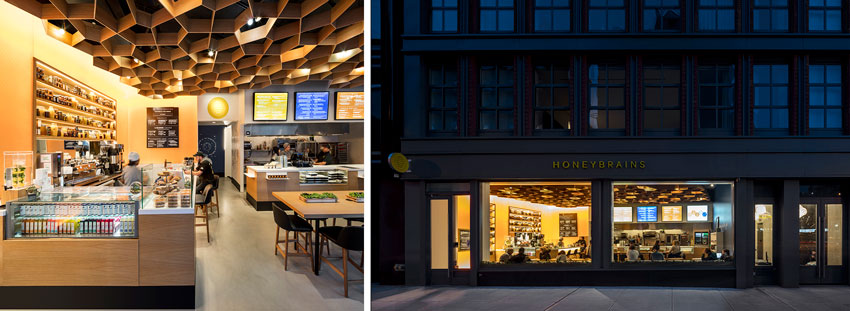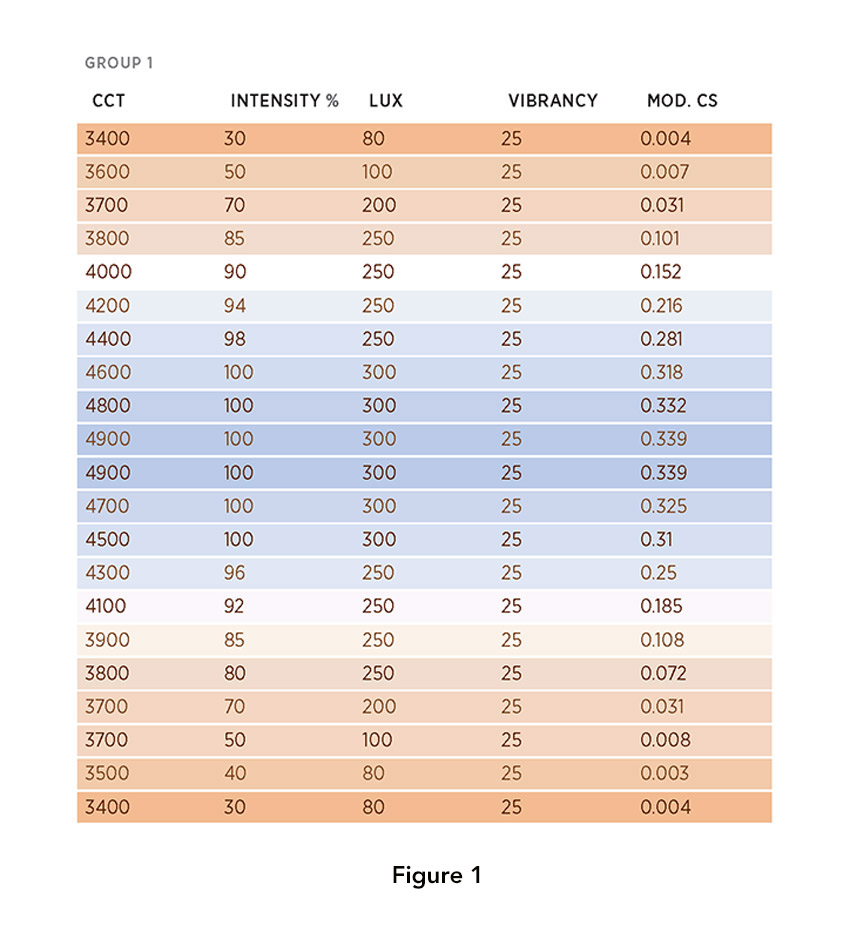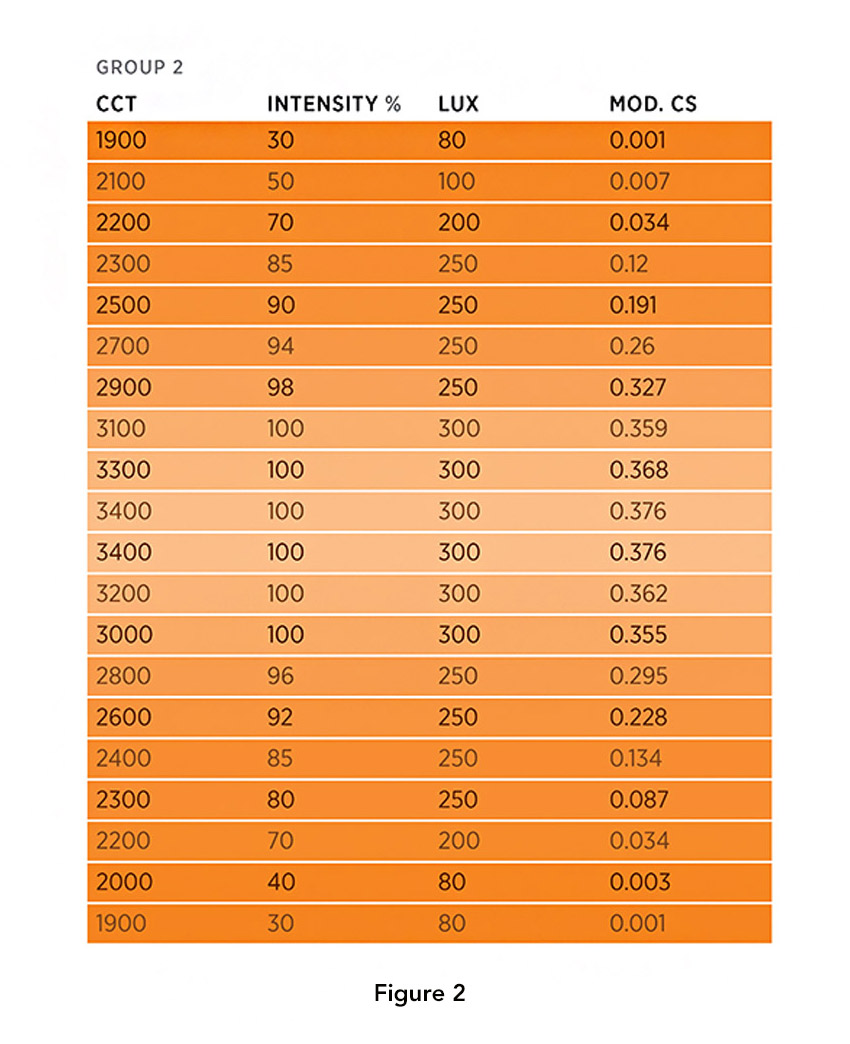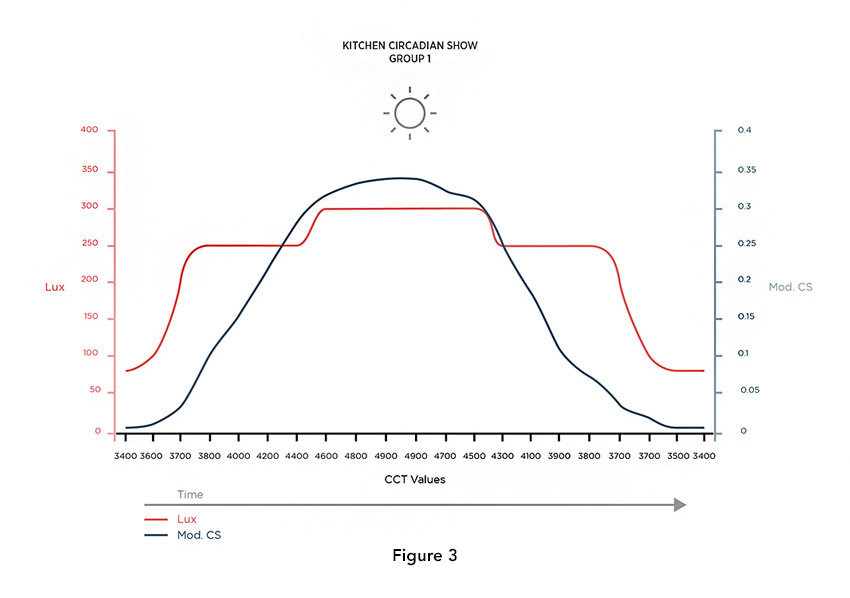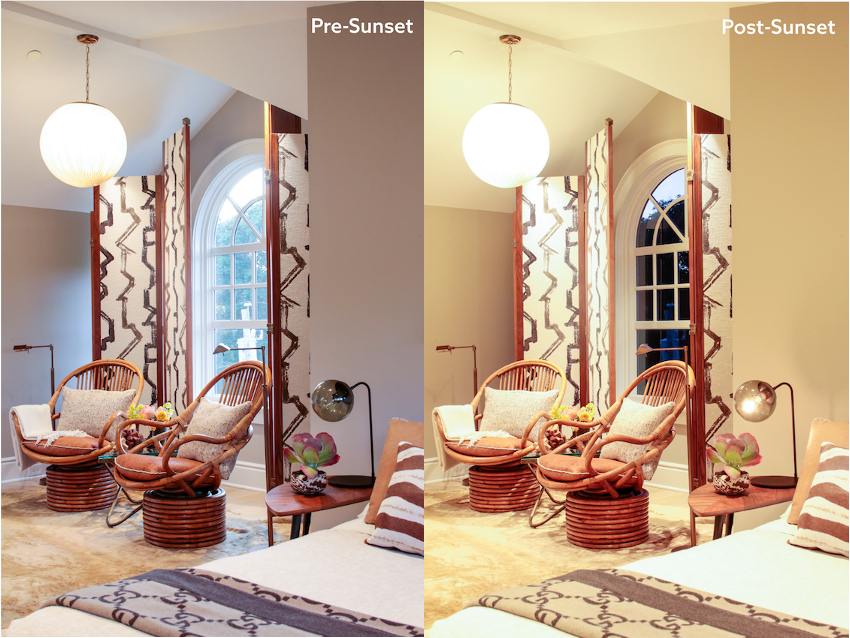This CE Center article is no longer eligible for receiving credits.
People are generally aware of the natural daily cycle of sunrise, morning, mid-day, afternoon, sunset, and night. However, we aren’t all necessarily aware of the ways our bodies are innately wired to respond to that daily rhythm. Scientists have begun to identify the intricate and intimate connection our bodies have with this daily cycle, which is referred to as our circadian rhythm, or body clock. Circadian rhythm, derived from the Latin term “circa diem,’’ literally means “approximately one day’’ and is set at slightly over 24 hours. The general consensus is that this rhythm is much more important for human health than may have been previously thought. It has been found to heavily influence sleep as well as most biological processes, including hormone production, metabolism, core body temperature variations, and cell regeneration, among others. In response to the numerous scientific findings that back this up, there are new lighting system products that can help us reinforce circadian rhythms using electric lighting. Referred to as dynamic lighting, these systems use digital controllers paired with carefully selected light fixtures to adjust and control the intensity, brightness, and color of electric lighting across the day with the intent of mimicking the natural changes in sunlight from dawn to dusk. In so doing, they are providing a means for architects and other design professionals to create spaces for living, working, and playing that reinforce our natural circadian rhythms, which in turn promotes better health and well-being for the building occupants.

Photo courtesy of Ketra/John Muggenborg
Project: Global Ad Agency Headquarters
Location: New York City
Architect: Foster & Partners
Lighting Design: Tillotson Design Associates
An advanced, dynamic lighting and controls system can be implemented throughout a workplace to emit high-quality light that is crisp and bright during the day, and soft and warm in the evening. This helps ensure employees are always getting the right light at the right time of day to support their natural circadian rhythms.
What Are Circadian Rhythms?
Circadian rhythms act like an internal metronome that ticks steadily along and tells our bodies when to adjust proteins and hormones that trigger waking and sleeping and influence many physiological processes. Although circadian rhythms are an endogenous (built-in, self-sustained) process of about 25 hours, they are adjusted to the local 24-hour environment by external cues, the most important of which is light and dark. This has been observed for some time but not fully understood until recently.
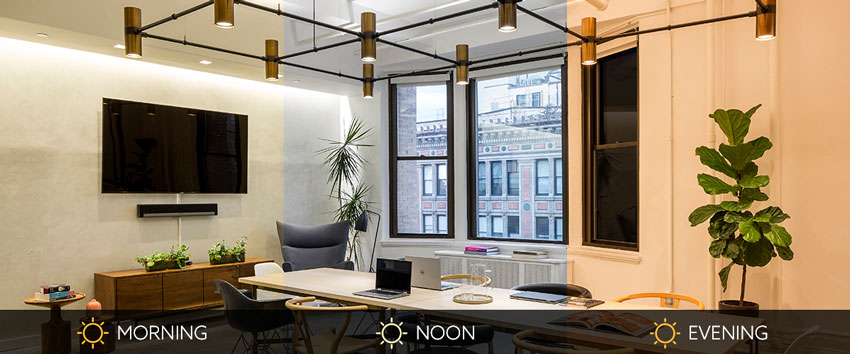
Image courtesy of Ketra/Magda Biernat
Project: Startup Office
Location:New York City
Architect: A+I
Lighting Design: Lighting Workshop
This New York City startup has a state-of-the-art lighting and controls system that uses an astronomical clock to seamlessly shift light throughout the day, simultaneously emitting the right light at the right time while supporting employees’ circadian rhythms.
Latest Research
In October 2017, three American scientists—Jeffrey C. Hall, Michael Rosbash, and Michael W. Young—won the 2017 Nobel Prize in physiology/medicine for their discoveries about the mechanisms that control an organism’s circadian responses to light and dark. According to the New York Times coverage of the event, the Nobel Prize committee said, “The scientists elucidated how a life-form’s ‘inner clock’ can fluctuate to optimize our behavior and physiology. Their discoveries explain how plants, animals and humans adapt their biological rhythm so that it is synchronized with the earth’s revolutions.”
In their work, the scientists were able to isolate a gene that responds to night and day conditions by accumulating or losing certain proteins. This discovery separates the circadian rhythm from past neuroscience studies that speculated that our brain was responsible for these rhythms. Instead, these new findings indicate that every cell in our bodies is wired to respond to the circadian pattern by virtue of the protein-regulated gene. They further found that misalignments in our internal rhythm can play a role in medical conditions and disorders since body temperature and blood pressure, among other things, rise and fall based on our circadian rhythm. It can also explain why people who travel across time zones experience “jet lag” as their body resets its internal clock to respond to the new pattern of light and dark. Through this work and others, circadian rhythms in people have thus been shown to be a fundamental and significant part of a healthy human existence.
Research by these noteworthy scientists and others point to a key factor in the circadian process that is found in the hormone melatonin. Research and testing has revealed that melatonin is normally produced by the body every evening and through the night but drops off notably toward morning. Its presence helps to activate and maintain sleep as well as alert a variety of biological processes to the approximate hour of the day. Light plays a direct role in signaling to the body when to secrete and suppress melatonin. This process entrains our 25-hour body clock to align with the 24-hour movement of the day. By contrast, in almost a directly opposing pattern, cortisol levels are highest during the early morning, then drop off notably during the evening and night, and raise sharply in the period for waking. Morning light has been found to be a key factor in stimulating the cortisol awakening response. Based on these observations, maintaining a constant internal biological circadian clock is seen as a critical component of getting adequate sleep and ultimately staying healthy.
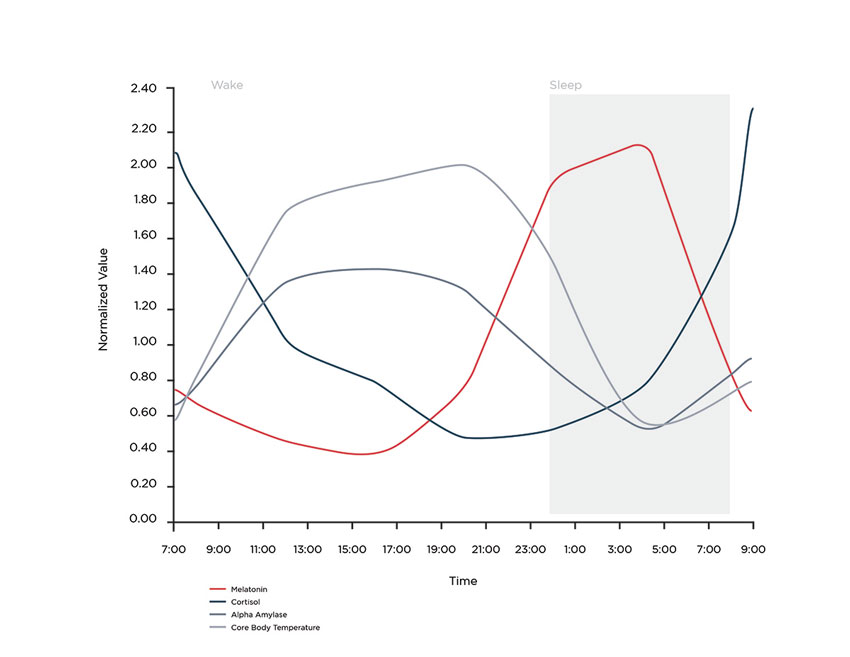
Image courtesy of Ketra
This graph shows the light-induced circadian rhythm that causes melatonin and cortisol levels to rise and fall during the day and night and establish our “body clock,” which regulates many physiological functions including body temperature, also shown.
Recognizing a normal circadian pattern leads to understanding the effect that an abnormal pattern can have. For example, delaying dim light exposure and the resulting melatonin onset, acts to advance the circadian clock, making it more difficult to fall asleep at night and wake up the next morning. Similarly, the amount and duration of light exposure with high concentrations of blue coloring during the day can also alter circadian patterns. All of this is significant since circadian disruption has been associated with a number of anomalies, as we will look at next.
People are generally aware of the natural daily cycle of sunrise, morning, mid-day, afternoon, sunset, and night. However, we aren’t all necessarily aware of the ways our bodies are innately wired to respond to that daily rhythm. Scientists have begun to identify the intricate and intimate connection our bodies have with this daily cycle, which is referred to as our circadian rhythm, or body clock. Circadian rhythm, derived from the Latin term “circa diem,’’ literally means “approximately one day’’ and is set at slightly over 24 hours. The general consensus is that this rhythm is much more important for human health than may have been previously thought. It has been found to heavily influence sleep as well as most biological processes, including hormone production, metabolism, core body temperature variations, and cell regeneration, among others. In response to the numerous scientific findings that back this up, there are new lighting system products that can help us reinforce circadian rhythms using electric lighting. Referred to as dynamic lighting, these systems use digital controllers paired with carefully selected light fixtures to adjust and control the intensity, brightness, and color of electric lighting across the day with the intent of mimicking the natural changes in sunlight from dawn to dusk. In so doing, they are providing a means for architects and other design professionals to create spaces for living, working, and playing that reinforce our natural circadian rhythms, which in turn promotes better health and well-being for the building occupants.

Photo courtesy of Ketra/John Muggenborg
Project: Global Ad Agency Headquarters
Location: New York City
Architect: Foster & Partners
Lighting Design: Tillotson Design Associates
An advanced, dynamic lighting and controls system can be implemented throughout a workplace to emit high-quality light that is crisp and bright during the day, and soft and warm in the evening. This helps ensure employees are always getting the right light at the right time of day to support their natural circadian rhythms.
What Are Circadian Rhythms?
Circadian rhythms act like an internal metronome that ticks steadily along and tells our bodies when to adjust proteins and hormones that trigger waking and sleeping and influence many physiological processes. Although circadian rhythms are an endogenous (built-in, self-sustained) process of about 25 hours, they are adjusted to the local 24-hour environment by external cues, the most important of which is light and dark. This has been observed for some time but not fully understood until recently.

Image courtesy of Ketra/Magda Biernat
Project: Startup Office
Location:New York City
Architect: A+I
Lighting Design: Lighting Workshop
This New York City startup has a state-of-the-art lighting and controls system that uses an astronomical clock to seamlessly shift light throughout the day, simultaneously emitting the right light at the right time while supporting employees’ circadian rhythms.
Latest Research
In October 2017, three American scientists—Jeffrey C. Hall, Michael Rosbash, and Michael W. Young—won the 2017 Nobel Prize in physiology/medicine for their discoveries about the mechanisms that control an organism’s circadian responses to light and dark. According to the New York Times coverage of the event, the Nobel Prize committee said, “The scientists elucidated how a life-form’s ‘inner clock’ can fluctuate to optimize our behavior and physiology. Their discoveries explain how plants, animals and humans adapt their biological rhythm so that it is synchronized with the earth’s revolutions.”
In their work, the scientists were able to isolate a gene that responds to night and day conditions by accumulating or losing certain proteins. This discovery separates the circadian rhythm from past neuroscience studies that speculated that our brain was responsible for these rhythms. Instead, these new findings indicate that every cell in our bodies is wired to respond to the circadian pattern by virtue of the protein-regulated gene. They further found that misalignments in our internal rhythm can play a role in medical conditions and disorders since body temperature and blood pressure, among other things, rise and fall based on our circadian rhythm. It can also explain why people who travel across time zones experience “jet lag” as their body resets its internal clock to respond to the new pattern of light and dark. Through this work and others, circadian rhythms in people have thus been shown to be a fundamental and significant part of a healthy human existence.
Research by these noteworthy scientists and others point to a key factor in the circadian process that is found in the hormone melatonin. Research and testing has revealed that melatonin is normally produced by the body every evening and through the night but drops off notably toward morning. Its presence helps to activate and maintain sleep as well as alert a variety of biological processes to the approximate hour of the day. Light plays a direct role in signaling to the body when to secrete and suppress melatonin. This process entrains our 25-hour body clock to align with the 24-hour movement of the day. By contrast, in almost a directly opposing pattern, cortisol levels are highest during the early morning, then drop off notably during the evening and night, and raise sharply in the period for waking. Morning light has been found to be a key factor in stimulating the cortisol awakening response. Based on these observations, maintaining a constant internal biological circadian clock is seen as a critical component of getting adequate sleep and ultimately staying healthy.

Image courtesy of Ketra
This graph shows the light-induced circadian rhythm that causes melatonin and cortisol levels to rise and fall during the day and night and establish our “body clock,” which regulates many physiological functions including body temperature, also shown.
Recognizing a normal circadian pattern leads to understanding the effect that an abnormal pattern can have. For example, delaying dim light exposure and the resulting melatonin onset, acts to advance the circadian clock, making it more difficult to fall asleep at night and wake up the next morning. Similarly, the amount and duration of light exposure with high concentrations of blue coloring during the day can also alter circadian patterns. All of this is significant since circadian disruption has been associated with a number of anomalies, as we will look at next.
How Circadian Rhythms Impact Sleep Patterns
In addition to the overall research described above, there are numerous other studies that look at some specific aspects of the connection between circadian rhythms and people. Some of these studies are borne out of the fact that most people in our contemporary society spend more time indoors than outside. In fact, studies show that the average American spends 90 percent of his or her time indoors, without access to adequate natural light.1 Nonetheless, it is common for people to inherently recognize the connection between natural sunlight and the healthy functioning of our bodies. Many people wish they could be outdoors more, incorporating walks into their days and getting away from their computer screens—a basic desire to reduce an indoor lifestyle and spend more time exposed to natural sunlight. It seems that we have an inherent sense of what scientific and health research are delving into to discern. These include the following types of studies and findings.
Getting a Good Night’s Sleep
People who spend the majority of their day surrounded by static indoor lighting systems rather than natural light that shifts during the day have been the focus of a number of studies. We have already noted that it has been determined that light—and especially natural shifts in daylight—is the number-one component in setting our body clocks. These clocks, or circadian rhythms, tell our bodies when to wake and sleep and are important to good health.
A study published in the June 2017 edition of Sleep Health reported on research conducted in five buildings managed by the U.S. General Services Administration.1 This study recruited 109 participants, of whom 81 participated in both winter and summer. Using a device calibrated to measure light that is effective for the circadian system (circadian-effective light), researchers collected personal light exposures in office workers and related them to their sleep and mood. It was determined that office workers who received higher levels of circadian-effective light were associated with reduced sleep onset latency (especially in winter), increased phasor magnitudes (a measure of circadian entrainment), and increased sleep quality compared to office workers who received lower levels of circadian-effective light. High levels of circadian-effective light during the entire day were also associated with increased mood (from 5–10 percent on CES-D scale), reduced depression, and increased sleep quality (10–15 percent fewer disturbances during their sleep). This study is the first to measure personal light exposures in office workers using a calibrated device that measures circadian-effective light and relates those light measures to mood, stress, and sleep. The study’s results underscore the importance of daytime light exposures for sleep health.
High levels of circadian-effective light during the entire day are also associated with increased mood (from 5–10 percent on CES-D scale), reduced depression, and increased sleep quality (10–15 percent fewer disturbances during their sleep).
Windows and Sleep Health
When it comes to the impact of windows and daylight exposure on the overall health and sleep quality of office workers, a 2014 study provides some insights.5 This research examined the impact of daylight exposure on the health of office workers from the perspective of subjective well-being and sleep quality as well as measures of light exposure, activity, and sleep-wake patterns. Measurement was performed using actigraphy, which is a non-invasive method of monitoring human rest/activity cycles. A small, wrist-watch-like actigraph unit, also called an actimetry sensor, was worn for a week to measure gross motor activity. Participants included 27 workers working in windowless environments and 22 comparable workers in workplaces with significantly more daylight. Well-being of the office workers was measured by a standard metric while sleep quality was measured by Pittsburgh Sleep Quality Index (PSQI). In addition, a subset of participants—10 workers in windowless environments and 11 workers in workplaces with windows—had actigraphy recordings to measure light exposure, activity, and sleep-wake patterns.
The study found that workers in windowless environments reported poorer scores than their counterparts on two dimensions—role limitation due to physical problems and vitality—as well as poorer overall sleep quality from the global PSQI score and the sleep disturbances component of the PSQI. Compared to the group without windows, workers with windows at the workplace had more light exposure during the workweek, a trend toward more physical activity, and longer sleep duration as measured by actigraphy. Results suggest that architectural design of office environments should place more emphasis on sufficient daylight exposure of the workers in order to promote office workers’ health and well-being. This work is reinforced by other studies that show sleep patterns in people with proper circadian rhythms showed an increase in sleep duration an average of 46 minutes compared to people with disrupted rhythms.1 Similarly, the quality of circadian reinforced sleep was measured to increase by 10-15 percent.2

Photo courtesy of Ketra/Magda Biernat
Project: Creative Technology Company Headquarters
Location: New York City
Architect: A+I
Lighting Design: Lighting Workshop
In 2016, this tech office’s global headquarters was given Interior Design’s Best of Year Award in the extra-large creative/tech office category. The office environment includes an advanced lighting and controls system that flawlessly shifts throughout the day, providing natural light that is energizing and crucial for promoting employees’ productivity and overall wellness.
Light Before Bedtime
A more detailed aspect of these observations is the effect of exposure to room light before bedtime, which can suppress melatonin onset and shorten melatonin duration in humans. A 2011 study hypothesized that when people have bright light on in their rooms in the evening, it makes it harder for them to obtain healthy rest because they are not producing enough melatonin.7 In the study, they tested the quality of sleep of those who were exposed to room light (200 lux) versus dim light (3 lux). Participants were healthy in the 18- to 30-year-old range and were housed in the same facility for five days. One group was exposed to full-room light, and one group received dim light before bed. Compared with dim light, exposure to brighter room light before bedtime resulted in suppressed melatonin, resulting in a later melatonin onset in 99 percent of individuals and shortening melatonin duration by 90 minutes. This means that participants exposed to brighter room light got less sleep overall. It was found that room light exerts a profound suppressive effect on melatonin levels and shortens the body’s internal representation of night duration. Exposure to electric light in the late evening disrupts melatonin signaling and disrupts sleep, thermoregulation, blood pressure, and glucose homeostasis.
Blue light in particular has been shown to negatively impact melatonin production so exposure to it in the evening hours can also trigger the melatonin delay. That is why leading manufacturers of smartphones and tablets now have a night-shift mode on their devices in an attempt to reduce the negative impact of blue light exposure when used in the evening or at night.
Circadian Reinforced Sleep Benefits
Looking at the positive side, some studies have focused on the benefits of providing bright light in the daytime and dimmer light in the evening, revealing some specific positive effects. These studies showed that productivity in the workplace increased by 5-25 percent while people’s moods improved by a noticeable 5–10 percent on the CES-D scale.2,4 With many people seeking sleeping-aid medications to make it through the next day, it would appear they could find better relief by focusing on the conditions that help with circadian rhythms.
Productivity in the workplace increased by 5–25 percent while people’s moods improved by a noticeable 5–10 percent.2,4
How Circadian Rhythms Can Affect Overall Health
Recognizing that many people’s internal body clocks can be out of sync with nature, we also need to recognize that more than just sleep is impacted. Since the Nobel Prize-winning scientists have found genes in every cell are tied in to circadian rhythms and proteins regulation, it should not be surprising to learn that hormones and overall metabolism of the body are affected too. This means that the health of the entire body can be impacted, positively or negatively, depending on the regularity and consistency of circadian rhythms. When the patterns are disrupted, studies have suggested a linkage to some serious illnesses.
The health of the entire body can be impacted, positively or negatively, depending on the regularity and consistency of circadian rhythms.
Diabetes Connections
Diabetes is a prevalent disease, and an internal medicine study examined whether short or poor sleep is associated with glycemic control in African Americans with type 2 diabetes.8 They conducted a cross-sectional study of volunteers with type 2 diabetes interviewed at the University of Chicago Hospitals, Chicago. The final analysis included 161 participants. Glycemic control was assessed by hemoglobin A1c (HbA1c) levels obtained from medical charts. Sleep quality was assessed using the Pittsburgh Sleep Quality Index (PSQI). In this sample, sleep duration and quality were significant predictors of HbA1c, a key marker of glycemic control. Combined with existing evidence linking sleep loss to increased diabetes risk, these data suggest that optimizing sleep duration and quality should be tested as an intervention to improve glucose control in patients with type 2 diabetes.
Cardiovascular Connections
The relationship between cardiovascular disease and circadian rhythms was reported on in 2011 in the Journal of Cardiology.9 The study indicated that both the physiological and pathological functions of cardiovascular organs are closely related to circadian rhythm since heart rate, blood pressure, and endothelial function show diurnal variations within a day. Recent progress in studying the functions and molecular mechanisms of the biological clock brought forth the idea that intrinsic circadian rhythms are tightly related to cardiovascular pathology. In addition to this central clock, each organ has its own biological clock system, termed the peripheral clock. Each cardiovascular tissue or cell, including heart and aortic tissue, cardiomyocyte, vascular smooth muscle cell, and vascular endothelial cell, also has intrinsic biological rhythm. Until recently, little was known about the roles of peripheral clocks in cardiovascular organs. However, studies using genetically engineered mice revealed their contributions during the process of disease progression. Loss of synchronization between the internal clock and external stimuli can induce cardiovascular organ damage. Discrepancy in the phases between the central and peripheral clocks also seems to contribute to progression of the disorders. Elucidation of the precise roles of biological clocks in cardiovascular organs will provide more profound insights into the relevance of the circadian rhythm in cardiac pathology. This time-of-day-based strategy may innovate a new paradigm in the prevention and treatment of cardiovascular disorders.

Photo courtesy of Ketra/Magda Biernat
Project: Creative Technology Company Headquarters
Location: New York City
Architect: A+I
Lighting Design: Lighting Workshop
Most office lighting is too dim in the daytime and too bright at night. In this office, the light is just right at any time of day. The fully customizable lighting and controls system allows for flexible and productive working spaces throughout the entire office.
Cancer Connections
The impact of breast cancer on women across the world has been extensive and severe, and the relevance of human melatonin regulation has also been studied.14 As the prevalence of breast cancer is greatest in industrialized regions, exposure to light at night has been proposed as a potential risk factor. This theory is supported by the epidemiological observations of decreased breast cancer in blind women and increased breast cancer in women who do shift-work. (Separate studies have suggested rotating and night shifts can impact circadian rhythms, melatonin production, and increase health risks.13) In addition, human, animal, and in vitro studies that have investigated the melatonin-cancer dynamic indicate an apparent relationship between light, melatonin, and cancer, albeit complex. Under highly controlled exposure circumstances, the research shows that less than 1 lux of monochromatic light elicited a significant suppression of nocturnal melatonin.
In view of the possible link between light exposure, melatonin suppression, and cancer risk, it is important to continue to identify the basic related ocular physiology. The study authors conclude that visual performance rather than circadian function has been the primary focus of architectural lighting systems. It is now necessary to reevaluate lighting strategies, with consideration of circadian influences, in an effort to maximize physiological homeostasis and health.
Wellness With Natural Light Indoors
With an understanding of the significance of human circadian rhythms, it now becomes quite obvious that when a building does not provide connections to natural light, it takes away the visual cues that keep our body clocks in line and affects well-being. Large buildings without views to the exterior and natural daylight need to rely on electric lighting that is typically uniform throughout the day and often contains a lot of blue light in its output. That means people who need to spend extended hours in these buildings are at risk for all of the negative symptoms of interrupted circadian rhythms discussed above. In essence, the design of the building is trading off the well-being of the occupants for some presumed efficiency in the building design.
Daylighting is usually integrated into a building as an architectural statement and for energy savings, but the LEED rating system and others recognize that there are benefits from daylighting that extend far beyond that. When psychological and physiological aspects of natural light are considered, daylighting has been associated with higher productivity, lower absenteeism, fewer errors or defects in products, positive attitudes, reduced fatigue, and reduced eyestrain.4 Since the 1920s, studies have been conducted on worker productivity and daylight which indicate that office worker productivity can increase with the quality of light. Natural light increases attention and alertness during the post-lunch dip and is helpful in alertness for boring or monotonous work.
Because of research like this, the LEED building rating system has, from its beginning, always placed a value on natural daylight and views to the exterior as part of its indoor environmental quality section. It has based the credit and point requirements in this category on research into this area and the efforts of other notable and reliable organizations that have done work in this field. In recent years, it has acknowledged the work of the WELL Building Standard developed by the WELL Building Institute (WBI).

Photo courtesy of Ketra
Workplaces that are designed for natural light from outside and internal sources can improve health and well-being and help achieve LEED and WELL certification.
The WELL Building Standard
According to its stated purpose, The International WELL Building Institute (IWBI) is “a public benefit corporation that is leading the movement to promote health and wellness in buildings and communities everywhere.” Its primary rating tool, the WELL Building Standard, was launched in October 2014 after six years of research and development. It has gained recognition quickly as “the premier standard for buildings, interior spaces, and communities seeking to implement, validate, and measure features that support and advance human health and wellness,” (www.wellcertified.com).
The WELL Building Standard addresses eight areas within the built environment that influence human health: air, water, nourishment, fitness, comfort, mind, innovation, and the one we will focus on, light. With 100 main features listed in the WELL standard, 11 are focused on light, including such things as the quantity and quality of daylight, electrical light in a building, and the surfaces that the light strikes. One main feature in particular (#54) is focused on circadian lighting design, and one pilot feature (P3) is based on circadian emulation.
According to WELL: “All light—not just sunlight—can contribute to circadian photoentrainment. [Defined separately as “The entrainment (alignment) of an organism’s circadian rhythm to the pattern of light and dark in its environment.”] Given that people spend much of their waking day indoors, insufficient illumination or improper lighting design can lead to a drift of the circadian phase, especially if paired with inappropriate light exposure at night.” It goes on to point out, “Humans are continuously sensitive to light, and under normal circumstances, light exposure in the late night/early morning will shift our rhythms forward (phase advance), whereas exposure in the late afternoon/early night will shift our rhythms back (phase delay). To maintain optimal, properly synchronized circadian rhythms, the body requires periods of both brightness and darkness,” (www.standard.wellcertified.com/light).
The intent behind the lighting provisions of WELL is to “support circadian health by setting a minimum threshold for daytime light intensity.” This minimum light threshold helps the body remain fully awake during the morning and afternoon while diminishing light levels later in the day encourage rest and less activity. The process of design and certification under the WELL standard is based on equivalent melanopic lux (EML), which accounts for the effect of different levels of light and melatonin production.
Wellness in Practice
Many employers are seeing the value of using the WELL standard and other initiatives to invest in their employees, who are typically their most valuable and expensive asset. For example, if we look at a typical 50,000-square-foot office building and apply the rule of thumb of the 3-30-300 rule (which corresponds approximately to energy-rent-payroll in $/square foot/year) the employer is looking at a total expenditure of just over $16.5 million/year. In this case, 1 percent ($150,000) is devoted to energy, 9 percent ($1.5 million) devoted to rent and operations, while a whopping 90 percent ($15 million) is devoted to employee cost. Therefore, if we took steps to reduce energy consumption by 50 percent ($75,000), it would only have a small impact on the annual operating cost. Improving space utilization by 10 percent could have a larger impact by reducing rent and operating costs ($150,000). But improving worker productivity by just 5 percent could result in very dramatic savings ($750,000). And employing all three of these strategies together can achieve an annual economic benefit of close to $1 million/year. This is a far cry from the slice of the $3/square foot for energy cost that designers often use to justify investments in building upgrades, with the benefits to employees considered at best to be a bonus or side benefit rather than the main driver.
In a more specific example, a case study of Lockheed Martin and VeriFone facilities looked at improved light conditions for workers by integrating more daylighting in its new office building.4 At Lockheed Martin, the increase in daylight boosted productivity by 15 percent. At VeriFone, there was a reported increase in productivity after a year and a half of new conditions by 5 percent and a total product output increase of 25–28 percent, making the new building more cost effective. This case study indicates that the improved health of building occupants not only benefits employees but also employers and building owners because of improved performance.
Identifying Circadian Stimulus
Understanding the impacts and benefits of circadian reinforced light patterns raises the question of quantifying the degree to which different lighting types or levels actually trigger a human response. In that regard, the circadian stimulus (CS) of a light source has been developed. The CS is a calculated index that considers both the wavelengths and intensity of a given light source and assigns a weighting function representing the human circadian sensitivity to light. The higher the concentration of light in the blue wavelength range, as well as the higher the intensity of light (light delivered to the vertical plane at eye level), the higher the CS value. In order to enable the application and quantification of this metric, researchers have developed the circadian stimulus calculator for determining the CS value of a light source based on spectral power distribution and intensity. Inputs to the model are the spectral power distribution (SPD) of the light source and target illuminance (lux) level of the space.
The benefit of controlling interior lighting based on the CS is the full reinforcement of the body’s internal clock and circadian rhythms, thus maximizing productivity, mood, hormones, metabolism, and optimizing health as evidenced in the numerous studies looked at. In settings where sleep occurs (residential, hotels, health-care facilities), an advanced lighting system eliminates blue light exposure at night (which negatively impacts melatonin production) and helps regulate sleep cycles. In commercial buildings, the intent is to improve the well-being of people and employees in the building.
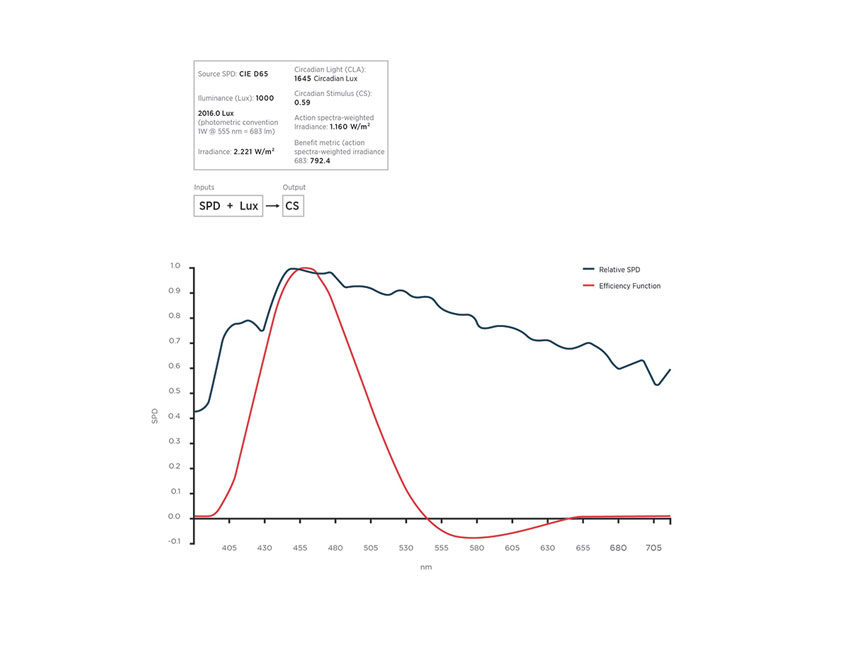
Image courtesy of Ketra
The circadian stimulus (CS) values of lighting can be measured and used to establish preferred circadian shows in buildings to provide very controlled light quality throughout the day.
Dynamic Lighting Systems To Produce Natural Light Patterns
Having identified the issues and effects related to the problem of disrupted circadian rhythms, we can now turn our attention to the solution found in a dynamic lighting system. Simply put, these systems change the light quality and levels over the course of a day in a manner that mimics natural daylight shifts and reinforces human circadian rhythms as a result. They do that based on simple but sophisticated light controllers tied to light fixtures that can be adjusted for light brightness and color. To be effective, they need to be located wherever there are people in a building or facility. This new, circadian-based method of “smart” controlled lighting has been shown to be the best way to meet WELL lighting standards, promote overall wellness and improve mood, productivity, and sleep. As such, it effectively replaces older lighting systems that use low-tech, static (on or off) switching that may not be optimized for the best quality of light.
The first step for a successful dynamic lighting system is to do an analysis of the interior spaces and the patterns of building usage by people. Then specific control patterns, called “circadian shows,” can be prepared, implemented, and modified as needed to suit building conditions. In order to schedule the circadian show lighting in a space such that it is optimized for the human circadian system, the circadian stimulus (CS) of the space should change as a function of time of day. The control of such circadian shows should run automatically with an astronomical clock and ideally interface with local manual overrides and occupancy sensors to turn off light when the space is unoccupied or when occupants are sleeping. Note that these circadian shows are not intended to mimic outdoor weather conditions, just to establish a natural, rhythmic pattern that the human body can recognize and use as light triggers to support a healthy circadian rhythm.
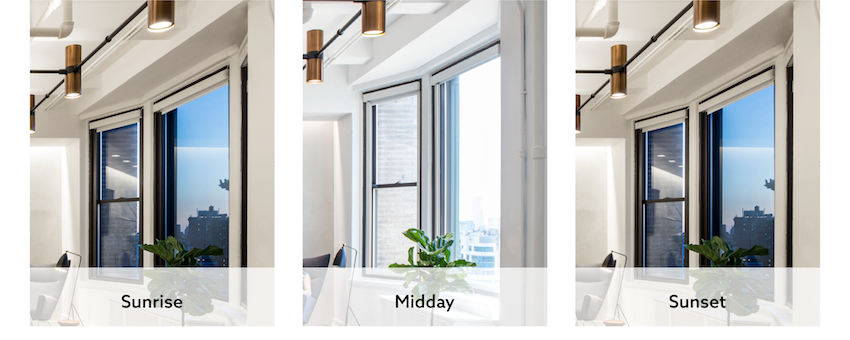
Image courtesy of Ketra/Magda Biernat
Project: Startup Office
Location: New York City
Architect: A+I
Lighting Design: Lighting Workshop
A healthy lighting solution evolves over the course of a day. The lighting and controls system at this New York office mimics the variations in natural sunlight—bright during the day to energize employees and dim at night to support healthy sleep cycles.
Of course, beyond control systems, the lighting fixtures and lamps are key parts of the system too. Fortunately, there is a wide range of high-quality light fixtures that can be used with a dynamic lighting system to produce white light as well as a full color spectrum. The lighting industry relies on the use of a correlated color temperature (CCT) rating to identify light color. The CCT is a specification of the color appearance of the light emitted by a lamp, related to a reference source when heated to a particular temperature, measured in degrees Kelvin (K). The lower the CCT rating, the warmer the color, (more yellows and amber) while the higher the rating, the cooler the color (more whites and blues). Dynamic lighting systems can take advantage of the full range of high-quality lighting products on the market that range from a very warm 1,400 K to a very cool 10,000 K. For reliability purposes, it is important to find lamps that maintain the desired color points over time. Further, narrow beam angles can be employed in fixtures to focus light in different spaces or enable ambient and art accent lighting from any ceiling height.
Part of the sophistication of advanced dynamic lighting systems is the ability to be fully customizable with a complete system of lighting and controls available. Users can easily adjust light levels and colors at any time, not limiting themselves to the times on the fixture schedule. There are also lighting products available that offer multiple warm dimming curves for a single product, enabling deeper control in any environment. Further, all lamps can be individually addressable through wireless control, regardless of how they are physically wired. The wireless solution simplifies installation while a wired ethernet connection provides reliable scalability.
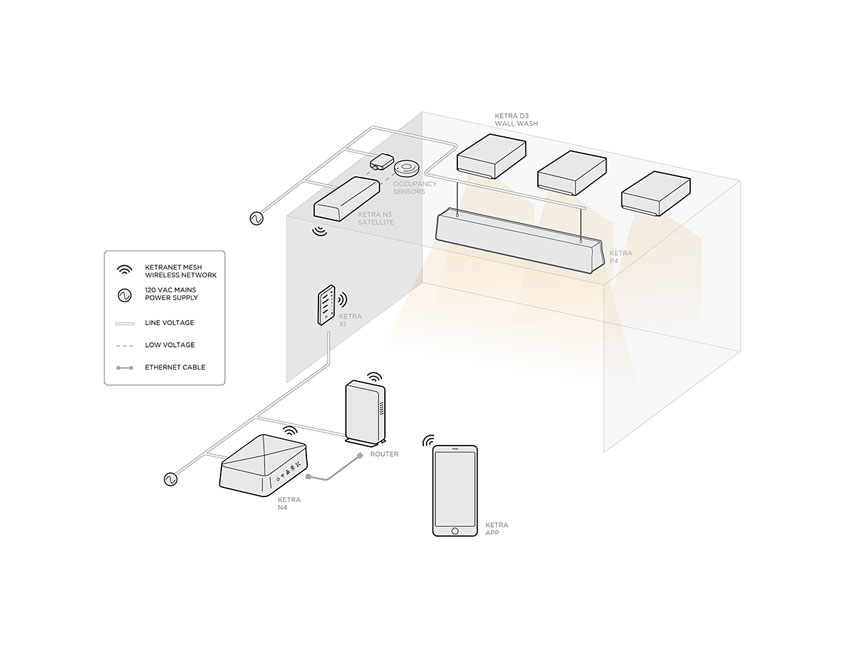
Image courtesy of Ketra
A complete dynamic lighting system includes wired and wireless controllers connected to a range of carefully selected luminaires and lamps.
A complete, advanced, dynamic lighting system includes onboard intelligence and a full system of sensors connected to lighting fixtures or lamps. An application programming interface (API) allows easy integration with different lighting systems, regardless of manufacturer.
Conclusion
Research and science have shown us that light is the major synchronizer of circadian rhythms to local times on earth. Further, melatonin is identified as a marker of the circadian clock which can be measured and a healthy model developed. Short-wavelength (blue) light maximally affects melatonin profiles and when combined with overall light exposure patterns during waking hours can have profound impacts on our circadian rhythms. However, we also know that light can also be a disruptor if applied at the wrong time. Therefore, a full circadian lighting solution should take into account the light source, intensity, add astronomical time and deploy it in such a way that is easy to install and automated throughout the day. Such solutions are found in advanced, coordinated, and well-designed dynamic lighting systems.

Photo courtesy of Ketra/Magda Biernat
Project: Retail and Office Space
Location: Chicago
Architect: A+I
This retail and office space is a staple of downtown Chicago that utilizes a lighting and controls system that is completely customizable and shifts with an astronomical clock to match the natural sunlight that beams in through the windows during the day. Building occupants are always exposed to light that helps promote their circadian rhythms while they’re in this retail/office space.
End Notes
1Figueiro, M.G.; Steverson, B.; Heerwagen, J.; et al. “The impact of daytime light exposures on sleep and mood in office workers.” Sleep Health. 2017.
2Foster, R.G. “Shedding Light on the Biological Clock.” Neuron. 1998.
3Sharma, S. and Kavuru, M. “Sleep and Metabolism: An Overview.” International Journal of Endocrinology. 2010. Web. 9 July 2017.
4Edwards, L. and Torcellini, P. A Literature Review of the Effects of Natural Light on Building Occupants. National Renewable Energy Laboratory. July 2002. Web. 24 July 2017.
5Boubekri, M.; Cheung, I.N.; Reid, K.J.; Wang, C.; and Zee, P.C. “Impact of Windows and Daylight Exposure on Overall Health and Sleep Quality of Office Workers: A Case-Control Pilot Study.” Journal of Clinical Sleep Medicine. 2014. Web. 14 July 2017.
6Figueiro M.G., Rea M.S., Stevens R.G., Rea A.C. Daylight and Productivity – A Possible Link to Circadian Regulation. Paper presented at EPRI/LRO 5th International Lighting Research Symposium in Palo Alto, California. 2002. Web. 14 December 2017.
7Gooley, J.J.; Chamberlain, K.; Smith, K.A.; et al. “Exposure to room light before bedtime suppresses melatonin onset and shortens melatonin duration in humans.” The Journal of Clinical Endocrinology & Metabolism. 2011.
8Knutson, K.L.; Ryden, A.M.; Mander, B.A.; and Van Cauter, E. “Role of Sleep Duration and Quality in the Risk and Severity of Type 2 Diabetes Mellitus.” Archives of Internal Medicine. 2006.
9Takeda N, Maemura K. Circadian clock and cardiovascular disease. Journal of Cardiology. 2011;57:249-256.
10Chen, L. and Yang, G. “Recent advances in circadian rhythms in cardiovascular system.” Frontiers in Pharmacology. 1 April 2015. Web. 26 July 2017.
11LeGates, T.A.; Fernandez, D.C.; and Hattar, S. “Light as a central modulator of circadian rhythms, sleep and affect.” Nature Reviews Neuroscience. 2014.
12Bower, B.; Bylsma, L.M.; Morris, B.H.; and Rottenberg, J. “Poor reported sleep quality predicts low positive affect in daily life among healthy and mood-disordered persons.” Journal of Sleep Research. 2010.
13Hunter, C.M. and Figueiro, M.G. Measuring Light at Night and Melatonin Levels in Shift Workers: A Review of the Literature. Biological Research for Nursing. 2017.
14Glickman, G.; Levin, R.; and Brainard, G.C. “Ocular Input for Human Melatonin Regulation: Relevance to Breast Cancer.” Neuroendocrinology Letters. 2002.
15Stevens, R.G.; Blask, D.E.; Brainard, G.C.; et al. “Meeting Report: The Role of Environmental Lighting and Circadian Disruption in Cancer and Other Diseases.” Environmental Health Perspectives 2007.
Peter J. Arsenault, FAIA, NCARB, LEED AP, is a practicing architect, green building consultant, continuing education presenter, and prolific author engaged nationwide in advancing building performance through better design. www.linkedin.com/in/pjaarch

|
Ketra offers the most advanced lighting system in the world, delivering high quality light that’s as dynamic as the sun itself. Shifting in color temperature from crisp and bright during the day to soft and warm in the evening, the innovative system was developed to meet the growing need for indoor spaces that promote wellness, productivity, and comfort among occupants. Ketra’s Natural Light gives cues that inform patterns of sleep and daytime activity, encouraging people to live healthier, more productive lives. The system is comprised of LED lighting, controls, software, and patented driver chip technology. www.ketra.com
|









